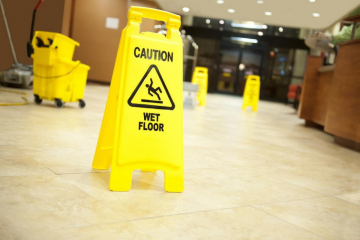Healthcare facilities are a highly regulated industry and many hospitals and ambulatory care settings work hard to reach and maintain appropriate accreditation goals. Much focus is placed on patient safety and the myriad of other quality measures healthcare facilities are required to meet.
Federal guidelines drive life safety, environment of care, and employee safety standards, but when it comes to employee safety, some OSHA standards receive more attention than others in the healthcare industry.
For example, 29 CFR 1910.1030, the bloodborne pathogen standard, states that employees who have occupational exposure to blood or other potentially infectious materials must be identified and that a written exposure control plan must be implemented to eliminate or reduce occupational exposure. Healthcare facilities tend to maintain their employee exposure control plans very well because it is a day-to-day reality and thus stays top-of-mind.
The larger question for Healthcare Occupational Health programs to consider is whether you are aware of the other hazards that your employees may be at risk for, and whether those programs as well managed.
Respirators
When employees may be exposed to tuberculosis, programs must comply with a variety of OSHA regulations such as the respiratory protection requirement (29 CFR 1910.134.) If employees are using respirators, then specifications for accident prevention with signs and tags (29 CFR 191.145), recordkeeping (29 CFR 1904), and the General Duty Clause come into play.
In addition to tuberculosis prevention programs, respirators may also be worn in other areas of the facility by workers other than those giving direct patient care, for example facilities maintenance workers who are working with asbestos. Gaps in respirator fit testing can occur if specific job hazard assessments have not been efficiently completed. Are employees who are administering hazardous aerosolized drugs appropriately fit tested? Have evaluations been done in laboratory areas to assess respiratory risk of employees working with chemicals such as formalin? Do employees really know what respirator they are fitted to and are these specific respirators stocked on the floors?
As an occupational health nurse, I once had to respond to a cluster of respiratory therapists experiencing dizziness while administering aerosolized Ribaviron to a patient. Although engineering controls were being used, it was discovered that the therapists were not fully protected because they were wearing improperly fitting N95 respirators. The model of respirator worn was not even considered part of the respiratory fit testing program.
Noise Exposure
Noise can be another overlooked OSHA standard in the healthcare setting. OSHA’s Occupational Noise Exposure Standard (29 CFR 1910.95) requires, where applicable, an effective hearing conservation program. In larger facilities that are set up to receive patients by helicopter, for example, flight nurses and other professionals who might transport patients from helipads need to be assessed to see if they should be part of a hearing conservation program. Additionally, sound surveys should be considered in areas such as on-site facility laundries and some maintenance rooms that can potentially expose employees to prolonged periods of loud noises throughout the day.
Chemical Exposure
In 2014, NIOSH released an alert entitled Preventing Occupational Exposures to Antineoplastic and Other Hazardous Drugs in Health Care Settings. This, along with the OSHA Hazard Communication Standard (29 CFR 1910.1200,) brings to the forefront the amount of hazardous chemicals and drugs that are handled on a daily basis by healthcare personnel and the subsequent importance of protection. Are your personnel adequately trained in the risk of handling these chemicals? Have the chemicals been assessed so that the proper PPE is being used when they are handled or administered? Are employees aware of waste anesthetic gases and their effects? These are all important questions for administrators to consider.
The Bottom Line
Although this blog certainly doesn’t go into the depth that a full OSHA audit would, it hopefully gets healthcare facilities thinking about going beyond the bloodborne pathogen standards. Consider the welfare of nurses who are not being fit-tested before administering aerosolized drugs, or who don’t have proper PPE while in contact with hazardous chemicals. Consider the essential healthcare workers who are not seen on a daily basis or who work behind the scenes while being exposed to high levels of noise. Examine your current approach and make sure it’s taking all of your employees (and all of their varied job activities) fully into account.
One way to see where gaps in your programs may lie is to conduct a regular in-house audit assessment to see which programs need reinforcement and what programs are working well. Antea Group has safety professionals that can conduct safety audits as well has help healthcare facilities write and develop robust programs that can meet regulatory regulations. As a partner in healthcare, Antea Group strives to help you keep your employees safe by recognizing and reducing hazards in the healthcare setting.
Want more news and insights like this?
Sign up for our monthly e-newsletter, The New Leaf. Our goal is to keep you updated, educated and even a bit entertained as it relates to all things EHS and sustainability.
Get e-NewsletterHave any questions?
Contact us to discuss your environment, health, safety and sustainability needs today.




